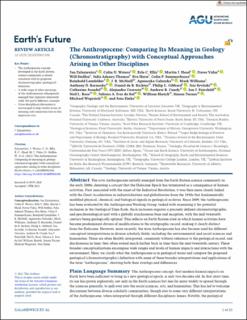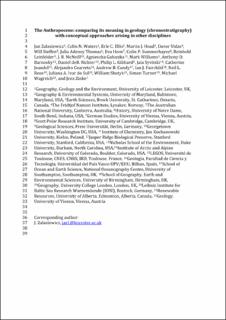| dc.contributor.author | Zalasiewicz, Jan | |
| dc.contributor.author | Waters, Colin N. | |
| dc.contributor.author | Ellis, Erle C. | |
| dc.contributor.author | Head, Martin J | |
| dc.contributor.author | Vidas, Davor | |
| dc.contributor.author | Steffen, Will | |
| dc.contributor.author | Thomas, Julia Adeney | |
| dc.contributor.author | Horn, Eva | |
| dc.contributor.author | Summerhayes, Colin | |
| dc.contributor.author | Leinfelder, Reinhold | |
| dc.contributor.author | McNeill, John R. | |
| dc.contributor.author | Galuszka, Agnieszka | |
| dc.contributor.author | Williams, Mark | |
| dc.contributor.author | Barnosky, Anthony | |
| dc.contributor.author | Richter, Daniel DeB | |
| dc.contributor.author | Gibbard, Philip L. | |
| dc.contributor.author | Syvitski, Jaia | |
| dc.contributor.author | Jeandel, Catherine | |
| dc.contributor.author | Cearreta, Alejandro | |
| dc.contributor.author | Cundy, Andrew B. | |
| dc.contributor.author | Fairchild, Ian J. | |
| dc.contributor.author | Rose, Neil L. | |
| dc.contributor.author | Ivar do Sul, Juliana A. | |
| dc.contributor.author | Shotyk, William | |
| dc.contributor.author | Turner, Simon | |
| dc.contributor.author | Wagreich, Michael | |
| dc.contributor.author | Zinke, Jens | |
| dc.date.accessioned | 2021-07-27T09:29:46Z | |
| dc.date.available | 2021-07-27T09:29:46Z | |
| dc.date.created | 2021-02-14T13:08:25Z | |
| dc.date.issued | 2021 | |
| dc.identifier.citation | Earth's Future. 2021, 9 (3), 1-25. | |
| dc.identifier.issn | 2328-4277 | |
| dc.identifier.uri | https://hdl.handle.net/11250/2765344 | |
| dc.description.abstract | The term Anthropocene initially emerged from the Earth System science (ESS) community in the early 2000s, denoting a concept that the Holocene Epoch has terminated as a consequence of human activities. First associated with the onset of the Industrial Revolution, it was then more closely linked with the Great Acceleration in industrialization and globalization from the 1950s that fundamentally modified physical, chemical and biological signals in geological archives. Since 2009, the Anthropocene has been evaluated by the Anthropocene Working Group (AWG), tasked with examining it for potential inclusion in the Geological Time Scale. Such inclusion requires a precisely defined chronostratigraphic and geochronological unit with a globally synchronous base and inception, with the mid‐20th century being geologically optimal. This reflects an Earth System state in which human activities have become predominant drivers of modifications to the stratigraphic record, making it clearly distinct from the Holocene. However, more recently, the term Anthropocene has also become used for different conceptual interpretations in diverse scholarly fields, including the environmental and social sciences and humanities. These are often flexibly interpreted, commonly without reference to the geological record, and diachronous in time; they often extend much further back in time than the mid‐20th century. These broader conceptualizations encompass wide ranges and levels of human impacts and interactions with the environment. Here, we clarify what the Anthropocene is in geological terms and compare the proposed geological (chronostratigraphic) definition with some of these broader interpretations and applications of the term ‘Anthropocene’, showing both their overlaps and differences. | |
| dc.language.iso | eng | |
| dc.subject | Begrepshistorie | |
| dc.subject | Conceptual history | |
| dc.subject | Geologi | |
| dc.subject | Geology | |
| dc.subject | Interdiscplinært samspill | |
| dc.subject | Interdisciplinary interplay | |
| dc.subject | Anthropocene | |
| dc.subject | Anthropocene | |
| dc.subject | Samfunnsvitenskap | |
| dc.subject | Social sciences | |
| dc.title | The Anthropocene: comparing its meaning in geology (chronostratigraphy) with conceptual approaches arising in other disciplines | |
| dc.type | Peer reviewed | |
| dc.type | Journal article | |
| dc.description.version | submittedVersion | |
| dc.description.version | publishedVersion | |
| dc.source.pagenumber | 1-25 | |
| dc.source.volume | 9 | |
| dc.source.journal | Earth's Future | |
| dc.source.issue | 3 | |
| dc.identifier.doi | 10.1029/2020EF001896 | |
| dc.identifier.cristin | 1889586 | |
| dc.relation.project | Fridtjof Nansens institutt: 480 | |
| dc.relation.project | Fridtjof Nansens institutt: 161 | |
| cristin.ispublished | true | |
| cristin.fulltext | preprint | |
| cristin.fulltext | original | |
| cristin.qualitycode | 1 | |

